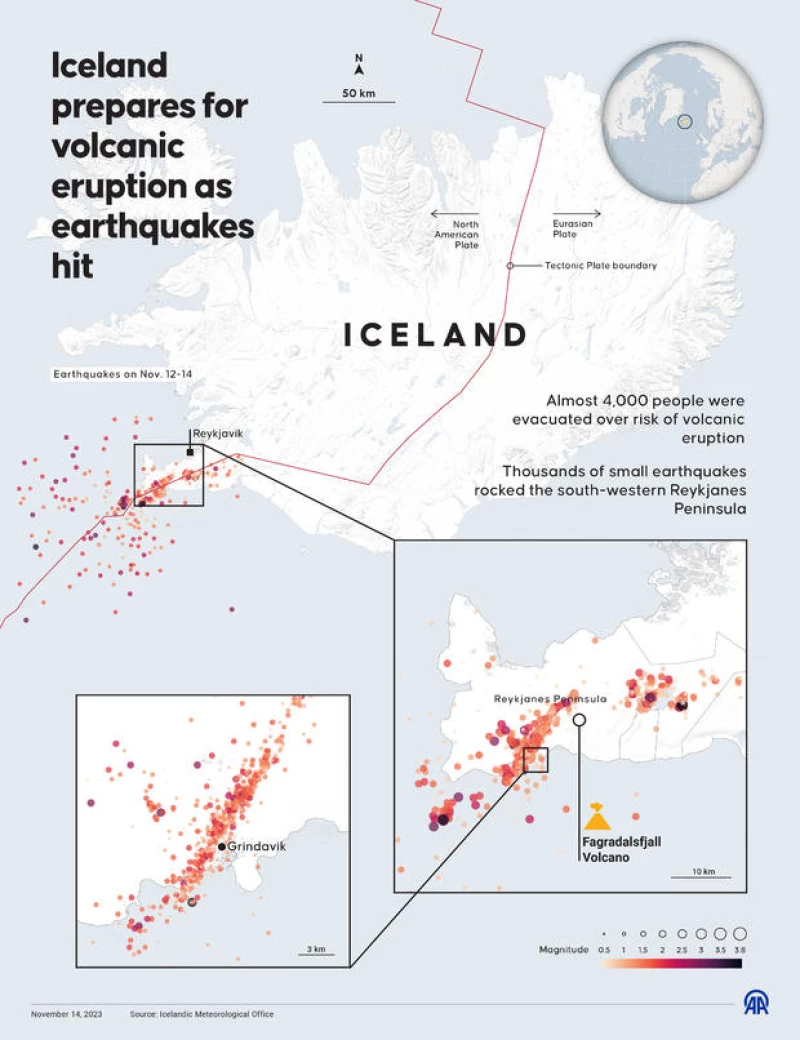According to meteorologists in Iceland, the country has experienced 800 earthquakes since midnight, following the 700 earthquakes that occurred on Tuesday. This increase in seismic activity comes after the detection of sulfur dioxide, a gas that indicates the presence of magma near the ground surface.
The majority of the earthquakes that occurred early Wednesday were located in the middle of a magma dyke, at a depth of approximately two to three miles. The meteorological office stated that there are clear signs of deformation in the area and that magma is still flowing, although part of the dyke appears to be solidifying.
In addition to the seismic activity, measurements of sulfur dioxide have also been detected. According to the U.S. Geological Survey, sulfur dioxide is a colorless gas with a pungent odor that can cause irritation to the eyes, nose, and throat. The presence of this gas indicates that magma is relatively close to the surface, and if detected when a volcano is not erupting, it could suggest an imminent eruption.
Volcanic Eruption Warning in Iceland
The Icelandic meteorological office has issued an update, stating that the likelihood of a volcanic eruption in Iceland remains high. This update comes after more than 700 earthquakes were recorded between midnight and 8 a.m. local time on Tuesday. Most of these earthquakes were classified as "micro-earthquakes" and the largest one had a magnitude of 3.1, causing only minor damage.
If an eruption occurs, the most likely location will be on the magma intrusion, according to the officials from the Icelandic Met Office. They have assessed the hazard and have not identified any other potential eruption sites.

The meteorological office has stated that the situation remains unchanged since yesterday, and the probability of an eruption is still considered high. The most likely location for the eruption is at the magma dyke.
Matthew James Roberts, the director of the Service and Research Division at the Icelandic Meteorological Office, expressed concern about the situation. He mentioned that the volcanic activity, which started on October 25, took a sudden turn on Friday. The magma intrusion, which is a thin sliver of magma, is more than 9 miles long and is located beneath the town of Grindavik.
Roberts also highlighted the proximity of the seismic activity to populated areas and infrastructure. The area affected includes the Blue Lagoon, a popular tourist destination near the international airport on Iceland's southern peninsula.
Magma Buildup in Iceland Causes Ground Deformation and Evacuations
The ground in Iceland is deforming and ballooning due to the increasing pressure and volume of magma building up beneath the Earth's surface, according to experts. Massive cracks and holes have been observed in the affected area.
The main concern is that the magma will eventually reach the surface, resulting in a volcanic eruption similar to those seen in Hawaii. This eruption could create fissures over a long distance, causing significant damage.
Hans Wierer, an Iceland resident, described the situation as desperate and paralyzed. He and his family, along with thousands of others in the earthquake-ridden area, have been forced to evacuate.
The Icelandic Civil Protection has declared a state of emergency, along with the meteorological office, warning that an eruption could occur at any time. The Reykjanes Peninsula, where the seismic activity is concentrated, is currently in an emergency and distress phase, indicating the potential for harm to people, communities, properties, and the environment.
Source: Icelandic Civil Protection







